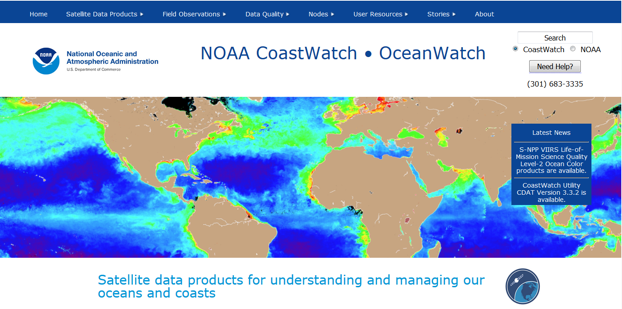Global and Coastal Ocean Satellite Data Products from Revised Website at NOAA CoastWatch/OceanWatch
The NOAA CoastWatch/OceanWatch Program and the Central Operations team at the Center for Satellite Applications and Research (STAR, the research and development arm of the NOAA National Environmental Satellite, Data and Information Service (NESDIS)) are pleased to share the news of the public release of the revised website at CoastWatch.NOAA.gov (Fig. 1). We think that the new design will facilitate users of all levels to find global and coastal ocean satellite data products to suit their applications. We hope that any disruption to routine users due to the switch-over was minimal, if not non-existent.
The interactive search tools (e.g., see Figs. 2 and 3), product pages and the supplemental information content will all continue to evolve, especially in the coming 3 months as we have the next short-term upgrade targeted for May 2017. You are invited to subscribe to our mailing list if you would like to be notified of changes to products or periodic news about website changes. For feedback on the new site, please email our helpdesk CoastWatch.Info@NOAA.gov or go to the “tell us how you use our data” link at the bottom of most of the pages. This short voluntary survey has sections for data usage and other feedback. We would appreciate hearing from you. We might even contact you for permission to share your stories on “Emily’s Post”.

Figure 1. New look and new functions at CoastWatch.NOAA.gov

Figure 2. Screen shot of the granule selector tool for NOAA VIIRS ocean color L2 swath data products and for Copernicus OLCI-Sentinel-3 true color (L1B).

Figure 3. Screen shot of the interactive space and time search tool, currently for NOAA VIIRS ocean color L2.
-Draw your spatial selection on the map
-Choose your date range from the calendar
-Preview data images of L2 granules
-Place granules on map to see their contribution
-Download list of filenames to use in automated (command mode) file retrievals
Future versions of this search tool will include additional datasets (environmental parameters, sensors, etc.).
In the longer term, NOAA CoastWatch/OceanWatch is continuing to develop and enhance parameter-based and multi-sensor interactive search tools. And, NOAA PolarWatch is coming soon.
Veronica P. Lance
Veronica.Lance@NOAA.gov
NOAA CoastWatch/OceanWatch Program Scientist
10 March 2017




